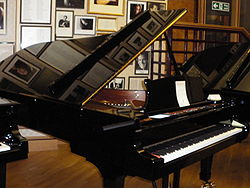Grand
In grand pianos, the frame and strings are horizontal, with the strings extending away from the keyboard. The action lies beneath the strings, and uses gravity as its means of return to a state of rest.
There are many sizes of grand piano. A rough generalization distinguishes the
concert grand (between about 2.2 m and 3 m/9.84 feet long) from the
parlor grand or
boudoir grand (about 1.7 m to 2.2 m) and the smaller
baby grand (around 1.5 m).
All else being equal, longer pianos with longer strings have larger, richer sound and lower
inharmonicity of the strings. Inharmonicity is the degree to which the
frequencies of
overtones (known as partials or
harmonics) sound
sharp relative to whole multiples of the fundamental frequency. This results from the piano's considerable string stiffness; as a struck string decays, its harmonics vibrate not from their termination but from a point very slightly toward the center (or more flexible part) of the string. The higher the partial, the further sharp it runs. Pianos with shorter and thicker strings, i.e. small pianos with short string scales, have more inharmonicity. The greater the inharmonicity, the more the ear perceives it as harshness of tone.
Inharmonicity requires octaves to be
"stretched", or tuned to a lower octave's corresponding sharp overtone rather than to a theoretically correct octave. If octaves were not stretched, single octaves would sound in tune, but double—and notably triple—octaves would be unacceptably narrow. When a small piano's octaves are stretched to match its inherent inharmonicity level, it creates an unacceptable imbalance among all the instrument's intervallic relationships, not just its octaves. But in a concert grand, the "stretch" of octaves retains harmonic balance even when aligning treble notes to a harmonic produced from three octaves below. This allows close and widespread octaves to sound pure, and enables
perfect fifths (another interval that modern ears expect to be pure) to remain virtually beatless throughout the instrument's compass. This gives the concert grand a brilliant, singing and sustaining tone quality, one of the principal reasons that full-size grands are used in the concert hall, and smaller grands chosen for domestic use where space and cost are considerations.
[edit] Upright
Upright pianos, also called vertical pianos, are more compact because the frame and strings are vertical. The hammers move horizontally, and are returned to their resting position by springs, which are prone to wear and tear. Upright pianos with unusually tall frames and long strings are sometimes called
upright grand pianos. Some authors classify modern pianos according to their height and to modifications of the action that are necessary to accommodate the height.
- Studio pianos are around 42 to 45 inches tall. This is the shortest cabinet that can accommodate a full-sized action located above the keyboard.
- Console pianos have a compact action (shorter hammers), and are a few inches shorter than studio models.
- The top of a spinet model barely rises above the keyboard. The action is located below, operated by vertical wires that are attached to the backs of the keys.
- Anything taller than a studio piano is called an upright.
[edit] Other types



